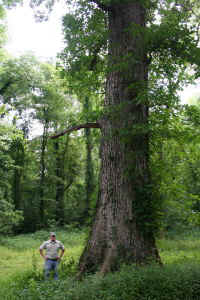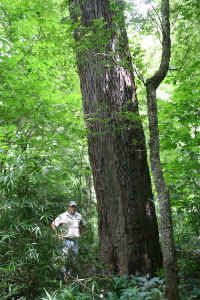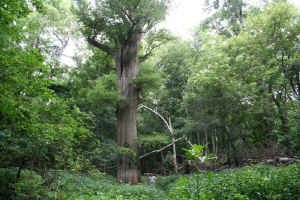ENTS--
After some hiatus in exploring the woods of the Arkansas region
for big
trees, I finally had an opportunity when one of our student
workers
asked me to check on a tree he thought may go as a state
champion.
Yesterday, he and I traveled to an area just north of the small
town of
Des Arc, Arkansas on the White River. This area is not far from
where
we made the field trip to Bayou DeView during the Old-Growth
Forest
Conference that was held in Arkansas last year.
 |
| Des Arc Cow Oak |
After
driving along the narrow jeep trails of this 2,500 acre
privately-owned parcel, we came to a stop at the tree of
interest. It
was a swamp chestnut oak (also known as a cow oak, or Quercus
michauxii). You may recall that I wrote of a very large example
of a
cow oak at Big Oak Tree State Park in Missouri. The oak we
visited
yesterday wasn't that big, but it was big enough--with a
circumference
at 6 feet (measured there because of the pronounced buttressing
of the
bole) of 70.1 inches, a sine height of 112 feet, and an average
crown
spread of just over 106 feet, it easily out-pointed the current
Arkansas
state champion. The tree (I'll send Ed some pictures to post on
the
website) is vigorous, with large, healthy branches full of
leaves and
little sign of decay or damage outside of an old lightning scar.
This
oak does not appear to me to be particularly old, and with a
healthy
crown and protection from logging, it has the potential to get
much
bigger.
 |
| Des Arc Honey Locust |
The woods
this tree is found in fascinated me with their diversity,
complex structure, lushness, and strong interrelationship with
the White
River. The river, which flows just to the west of the stands we
hiked
in, frequently (annually) floods the whole forest, depositing
large
quantities of nutrient-rich silt. The alluvium is, no doubt,
more
abundant than it probably had been historically, given all of
the
agriculture done in this watershed, and is also full of the
refuse of
life--especially human debris. The understory vegetation and the
lushness of the overstory are good indicators of the richness of
the
land. I was impressed by how much pawpaw grew in the understory,
and
the nettles, poison ivy, grape, greenbrier, cane, and other
plants
carpeted any areas that got enough light to support their
growth. Some
areas immediately adjacent to the river were dominated by black
willow,
while slower backwater sloughs and low areas tended to be
dominated by
baldcypress, water locust, and many other hardwood species I was
not
familiar with. The somewhat higher and older levees and bars
were
thickly mantled with a profusion of species, including
sugarberry, sweet
pecan, cow oak, honeylocust, sycamore, elms, silver maple, green
ash,
many hickory species, and several oaks, including Nuttall oak.
The
highest and driest parts were dominated primarily by
oaks--water,
willow, cherrybark, white, etc., with persimmons common along
the edges
of fields.
 |
| Des Arc Cypress |
After
measuring the big oak, we drove a little further along a trail
to
find some large cypress the student remembered. We hiked about
100
yards into the woods and soon came upon an old slough that was
rapidly
being filled by sediments from new floods. I noted one or two
old
cypress stumps in the slough that probably date back to when the
cypress
was originally logged long ago. A number of smaller cypress 100
years
old or less lined the old slough, but there were several
veterans that
survived the big cut, probably because of their poor form and
log
quality. They were plenty good to me, though! The biggest of
these
baldcypress was a stout ol' survivor of many a storm and flood.
Almost
82 inches at DBH, this cypress was 105 feet tall, and had little
taper
for much of this length. Two other cypress nearby each exceeded
65
inches DBH (I couldn't get a reliable height due to the thick
canopy,
but they are both also probably over 100 feet tall). Before we
left
this slough, we measured a couple of water locust at 15.7 and
19.8
inches DBH (estimated heights of between 50 and 70 feet).
Anybody
familiar with this species knows what a thorny challenge water
locust
can be...
We then started hiking back to the truck. On the way, we
measured a
sweet pecan at about 40 inches in diameter (hard to say exactly
due to a
thick coating of vines, including poison ivy). More notably, we
measured a tree we had originally spotted (and dismissed) while
driving
the trail. At 50.3 inches at DBH, at least 97 feet tall, and
with a 64
foot wide crown, this honeylocust also easily set a new state
record for
Arkansas! This was an unexpected bonus!
So, over the course of a couple hours, we found what should be
two new
state champions. The land has been largely cutover, but I
suspect there
are some other champions out there, given the size and fertility
of the
area and its relatively protected state. The student has
promised to
keep searching the area for big trees, so who knows what else
may be
lurking--the state (and probably national) champion tupelo gum
is only a
few miles from here, and a number of other champions can be
found in the
general region.
Don
*****************
Don Bragg, Ph.D.
Research forester
*****************
|